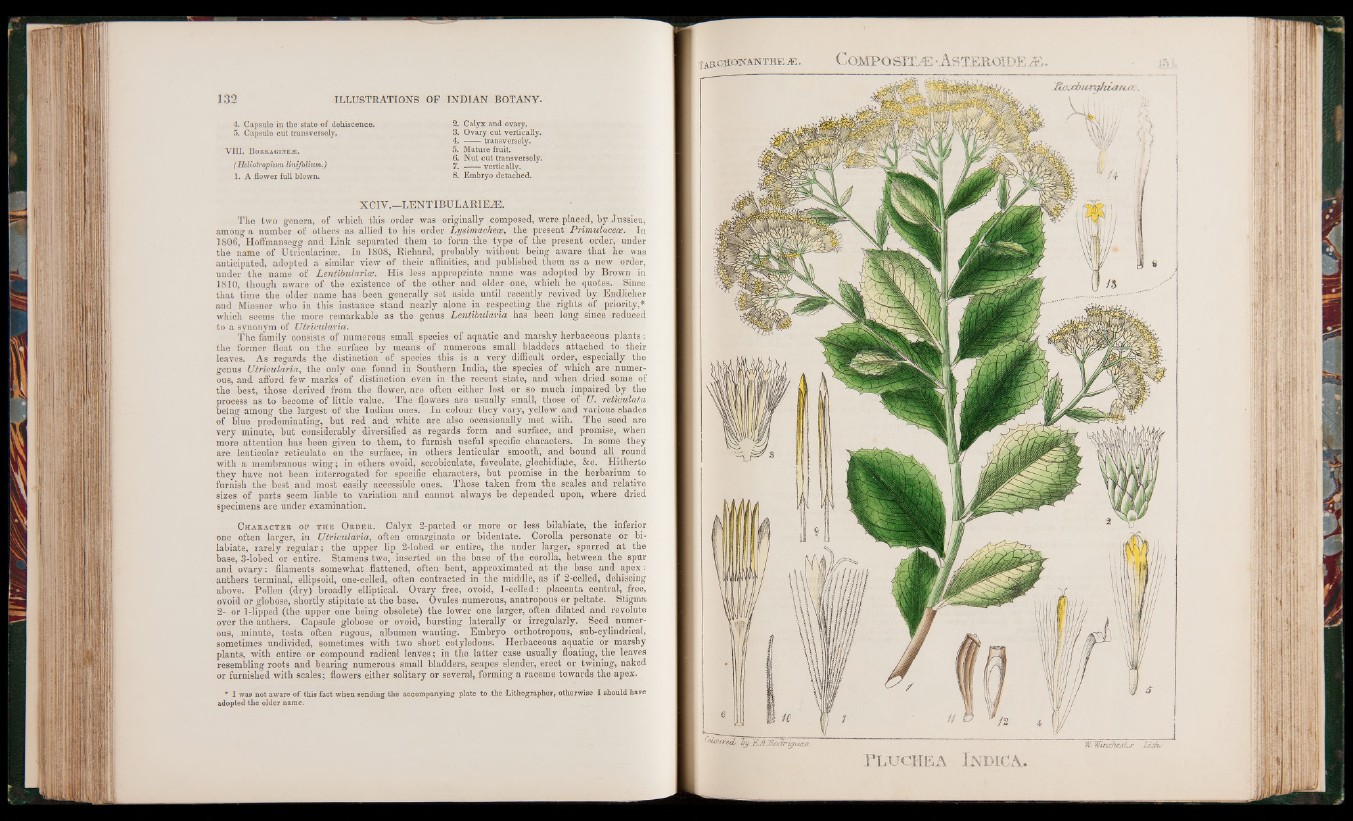
4. Capsule in the state of dehiscence.
5, Capsule cut transversely,
VIII. Borragineje.
(Heliotropium linifolium.)
1. A flower full blown.
2. Calyx and ovary,
3. Ovary cut vertically.
4. ------ transversely.
5. Mature fruit.
6. Nut cut transversely.
7. ------ vertically.
8. Embryo detached.
XCIV.—LENTIBULARIEiE.
The two genera, of which this order was originally composed, were placed, by Jussieu,
among a number of others as allied to his order Lysimacheos, the present Primulacece. In
1806, Hoffmansegg and Link separated them to form the type of the present order, under
the name of Utricularinse. In 1808, Richard, probably without being aware that he was
anticipated, adopted a similar view of their affinities, and published them as a new order,
under the name of Lentibularios. His less appropriate name was adopted by Brown in
1810, though aware of the existence of the other and older one, which he quotes. Since
that time the older name has been generally set aside until recently revived by Endlicher
and Miesner who in this instance stand nearly alone in respecting the rights of _priority,*
which seems the more remarkable as the genus Lentibularia has been long since reduced
to a synonym of Utricularia.
The family consists of numerous small species of aquatic and marshy herbaceous plants:
the former float on the surface by means of numerous small bladders attached to their
leaves. As regards the distinction of species this is a very difficult, order, especially the
genus Utricularia, the only one found in Southern India, the species of which are numerous,
and afford few marks of distinction even in the recent state, and when dried some of
the best, those derived from the flower, are often either lost or so much impaired by the
process as to become of little value. The flowers-are usually small, those of U. reticulata
being among the largest of the Indian ones. In colour they vary, yellow and various shades
of blue predominating, but red and white are also occasionally met with. The seed are
very minute, but considerably diversified as regards form and surface, and promise, when
more attention has been given to them, to furnish useful specific characters. In some they
are lenticular reticulate on the surface, in others lenticular smooth, and bound all round
with a membranous wing; in others ovoid, scrobiculate, foveolate, glochidiate, &c. Hitherto
they have not been interrogated for specific characters, but promise in the herbarium to
furnish the best and most easily accessible ones. Those taken from the .scales and relative
sizes of parts seem liable to variation and cannot always be depended upon, where dried
specimens are under examination.
Chabactee of the Oedee. Calyx 2-parted or more or less bilabiate, the inferior
one often larger, in Utricularia, often emarginate or bidentate. Corolla personate or bilabiate,
rarely regular; the upper lip 2-lobed or entire, the under larger, spurred ah the
base, 3-lobed or entire. Stamens two, inserted on the base of the corolla, between the spur
and ovary: filaments somewhat flattened, often bent, approximated at the base and apex:
anthers terminal, ellipsoid, one-celled, often contracted in the middle, as if 2-celled, dehiscing
above. Pollen (dry) broadly elliptical. Ovary free, ovoid, 1-celled: placenta central, free,
ovoid or globose, shortly stipitate at the base. Ovules numerous, anatropous or peltate. . Stigma
2- or 1 -lipped (the upper one being obsolete) the lower one larger, often dilated and revolute
over the anthers. Capsule globose or ovoid, bursting laterally or irregularly. Seed numerous,
minute, testa often rugous, albumen wanting. Embryo orthotropous, sub-cylindrical,
sometimes undivided, sometimes with two short cotyledons. Herbaceous aquatic or marshy
plants, with entire or compound radical leaves; in the latter case usually floating, the leaves
resembling roots and bearing numerous small bladders, scapes slender, erect or twining, naked
or furnished with scales; flowers either solitary or several, forming a raceme towards.the apex.
* I was not aware of this fact when sending the accompanying plate to .the Lithographer, otherwise I should have
adopted the older name.
mm